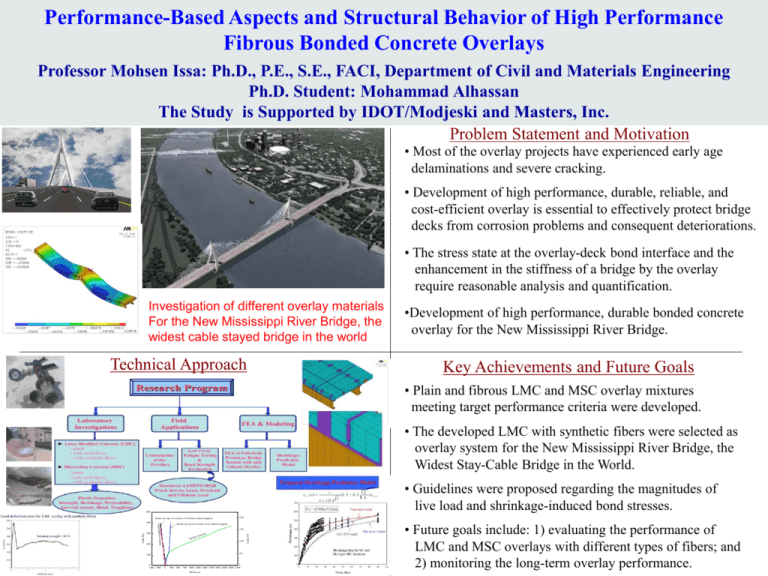ABcompiled_pt3
advertisement

Performance-Based Aspects and Structural Behavior of High Performance Fibrous Bonded Concrete Overlays Professor Mohsen Issa: Ph.D., P.E., S.E., FACI, Department of Civil and Materials Engineering Ph.D. Student: Mohammad Alhassan The Study is Supported by IDOT/Modjeski and Masters, Inc. Problem Statement and Motivation • Most of the overlay projects have experienced early age delaminations and severe cracking. • Development of high performance, durable, reliable, and cost-efficient overlay is essential to effectively protect bridge decks from corrosion problems and consequent deteriorations. • The stress state at the overlay-deck bond interface and the enhancement in the stiffness of a bridge by the overlay require reasonable analysis and quantification. Investigation of different overlay materials For the New Mississippi River Bridge, the widest cable stayed bridge in the world Technical Approach •Development of high performance, durable bonded concrete overlay for the New Mississippi River Bridge. Key Achievements and Future Goals • Plain and fibrous LMC and MSC overlay mixtures meeting target performance criteria were developed. • The developed LMC with synthetic fibers were selected as overlay system for the New Mississippi River Bridge, the Widest Stay-Cable Bridge in the World. • Guidelines were proposed regarding the magnitudes of live load and shrinkage-induced bond stresses. 500 Strain @ top of overlay 14 ft from central support 400 n 1500 ion Surf tens ace 1000 500 100 0 -500 -250 0 250 500 0 750 1000 1250 1500 1750 2000 2250 2500 2750 Strain, Load, kN 200 Surface compressio Load, kip 300 2000 Strain @ top of overlay over central support • Future goals include: 1) evaluating the performance of LMC and MSC overlays with different types of fibers; and 2) monitoring the long-term overlay performance. Experimental and Theoretical Behavior of Reinforced Concrete Beams and Columns Wrapped with CFRP-Composites Mohsen A. Issa, Ph.D., P.E., S.E., FACI, Department of Civil and Materials Engineering Ph.D Student: Rajai Alrousan Problem Statement and Motivation ▪ Worldwide repairing of aging infrastructure became necessary as the structural elements cease to provide satisfactory strength and serviceability, etc. ▪ Sudden failures (brittle) of RC columns and beams, are considered as the most disastrous failure modes that occur with no advance warning of tribulation. ▪ Use of CFRP-composites can provide substantial enhancements in the beams shear strength and column ultimate capacity. ▪ It is very beneficial and crucial to provide rationalized models that consider the concrete and structure nonlinearities. Technical Approach • Fabrication of reinforced concrete (RC) beams and columns and testing their behaviors with and without CFRP-composites. • Performing nonlinear finite element analysis (FEA) to simulate the response of the beams and columns. • Calibration and validation of the FEA models. • Expansion of the FEA to study additional critical issues related to the beams shear strength and ultimate strength of columns. • Use of the experimental and FEA results to provide rational models that predict the beam shear strength and column ultimate capacity based on the configuration of CFRP composites. Key Achievements and Future Goals • The study showed that the CFRP-composites is a very effective strengthening/repair system that provide substantial enhancements in the behaviors of beams and columns. • Guidelines and preliminary models were proposed to predict the shear strength of RC beams and ultimate strength of columns strengthened with CFRP-composites. • Various repair projects of beams and columns were implemented employing the recommendations of this research. • The current work is focusing onto rationalizing the proposed preliminary models to be applicable for any CFRP-composite configuration and concrete strength. Structural Health Monitoring System (SHMS) for Bridge Girders Retrofitted with CFRP Composites Mohsen A. Issa, Ph.D., P.E., S.E., FACI, Department of Civil and Materials Engineering The Study is Supported by the Illinois Toll Highway Authority Problem Statement and Motivation ▪ It is imperative that bridges are always open to traffic, resistant to natural disaster, and undaunted by millions of loading cycles. 250 200 210 MSC (plain) MSC (with synthetic fibers) MSC (with steel fibers) 150 ▪ Early signs of deterioration are often not seen because bridge components mask them. It is hard to visually inspect or using hardwiring sensors in some components of special bridges. ▪ Structural health monitoring (SHM) is the diagnostic monitoring of the integrity or condition of a structure capable of detecting and locating damage or degradation in its components. Strain, 100 50 0 -50 -100 -150 -200 - 230 -250 0 20 40 60 80 100 120 140 160 180 200 ▪ It is crucial to evaluate and recommend long-term bridge monitoring systems that are cost-effective, durable, and reliable. Time (days) Technical Approach • Health monitoring systems were incorporated in large-scale bridge members, full-scale bridge prototypes, and actual Toll Highway Authority bridges. • The critical locations were selected based on laboratory experimental programs and nonlinear finite element analysis. • The effectiveness of the health monitoring systems were evaluated based on: accuracy of data, simplicity of installation, cost, reliability, and durability. Key Achievements and Future Goals • Various health monitoring systems were incorporated in actual repair projects of damaged I-girders. The data is continuously collected and showed consistence results with the actual conditions of the repaired girders. • The current and future work are focused toward designing and selecting wireless health monitoring systems that are durable, reliable, and smart to send understandable and accurate messages about the conditions of the major bridge components. Development of an Innovative Prefabricated Full-Depth Precast Concrete Bridge Deck System for Fast Track Construction, Get in, Get out, and Stay out Mohsen A. Issa, Ph.D., P.E., S.E., FACI, Department of Civil and Materials Engineering The projects are Supported by Illinois Department of Transportation Problem Statement and Motivation • The interstate highway system is approaching its service life and urban congestion is increasing. Anticipated future costs of repair/reconstruction of the nation’s infrastructures are huge. • Utilization of innovative full-depth deck panel system (high performance, durable, ease and speed of construction, costsaving, aesthetic, minimal noise, and no interference with the traffic flow) leads to substantial reductions in the costs of repair and new construction projects. • The concerns about the performance of the components of the system and its constructability require systematic optimization to achieve high performance and fast construction. Technical Approach • All of the full-depth system major components (deck panels configurations, transverse joints, post-tensioning levels, shear connectors, overlay system, and materials) were tested and optimized based on consecutive studies included large scale specimens and prototypes. • Nonlinear finite element models were created to optimize the components and support the experimental testing. • Based on the findings, a full-scale prototype bridge full depth deck panel system was designed, fabricated, and tested with and without overlay simulating AASHTO HS-20 truck loading, overload, and ultimate load . Key Achievements and Future Goals • Complete innovative full-depth deck panel system with clear information about its constructability and details and performance of its components was developed . • The system is utilized in many new and repair bridge projects implementing the recommendations of this study. • Current and future research are focused onto generalizing the full-depth concept to develop totally prefabricated superstructure system (bridge deck and beams). • The developed full-depth system as well as the LMC overlay system will be utilized in the coming New Mississippi River Bridge Project (the widest stay-cable bridge in the world). Activity-Based Microsimulation Model of Travel Demand Kouros Mohammadian, PhD, S. Yagi, J. Auld, and T.H. Rashidi (PhD Candidates), CME, UIC Source of Funding: NIPC/CMAP, FACID, and IGERT (NSF) Synthetic Population Activity Generation Model Synthetic City Activity Scheduling Model ADS/HTS Surveys Synthesized Population Activity-Based Modeling Activity/Travel Microsimulation Executed Schedules Activities/ Tours/Trips Travel Demand Policy scenarios Highway/Transit Network Assignment Policy Analysis Vehicle/Fuel Condition Emission Model Technical Approach •The modeling framework utilizes both econometric and heuristic (rule-based) approaches •All human activities are related to broad project categories which have a common goal (e.g., Work, School, Entertainment, etc.) and tasks and activity episodes that are required to reach that goal are modeled •Activity participation is modeled at household/individual level (microsimulation) •Explicit representation of time/space of occurrence for all travel episodes, linked to associated activities •Activity scheduling model is linked to a population synthesizer, rescheduling and resource allocation models, and a regional network microsimulation and emission models Problem Statement and Motivation •Traditional four step travel demand models are widely criticized for their limitations and theoretical deficiencies •These problems lead the model to be less policy sensitive than desired •Travel is derived from participation in activities. This fact is not accounted for in 4-step models. Therefore, there is a need for a better modeling approach •An activity-based microsimulation travel demand model is considered that simulates activity schedules for all individuals Key Achievements and Future Goals •A comprehensive multi-tier activity-based microsimulation modeling system is developed. •A new population synthesizer is developed. •Activity scheduling/rescheduling decision rules are developed and applied to adjust the simulated daily activity patterns. •Intra-household interaction rules are developed and applied to account for joint activity generation and household maintenance activity allocation problems. •Transferability of activity scheduling/rescheduling decision rules across different spatial and temporal contexts are evaluated. •The microsimulation model is applied to evaluate future transportation policy scenarios. Travel Data Simulation and Transferability of Household Travel Survey Data Formatted PUMS Add-on Data in NHTS2001 Kouros Mohammadian, PhD and Yongping Zhang (PhD Candidate), CME, UIC Prime Grant Support: Federal Highway Administration (FHWA) Problem Statement and Motivation Population Synthesizer Synthetic Households with 33 Variables NHTS 2001 Transferability Model ANN Module Synthetic HHs with Cluster Membership Validation Data with Cluster Membership Look-up Tables Transferred Travel Attributes Bayesian Updating Monte Carlo Simulation Validation with Simulation Updated Transferred Travel Attributes •Household travel data is critical to transportation planning and modeling • Surveys are expensive tools • Emerging modeling techniques (e.g., microsimulation) need much richer datasets that do not exist in most metropolitan areas • Transferring or simulating data seems to be an attractive solution Simulated Travel Attributes Technical Approach •Considered a large set of socio-demographic, built environment, and transportation system variables to identify clusters of households with homogeneous travel behavior •Transferred cluster membership rules and cluster-based travel attributes to local areas •Calibrated/Validated travel data transferability model •Synthesized population for 5 counties of New York City with all their attributes •Updated parameters of the transferability model using a small local sample and Bayesian updating •Simulated travel attributes for the synthetic population •Validated the simulated data against actual observed data Key Achievements and Future Goals •A new travel forecasting modeling approach is designed and validated •The new approach significantly improves the process of travel demand forecasting •Using synthetically derived data found to be appealing •The appeal of the approach lies in its low-cost, relative ease of use, and freely available sources of required data •Improved Bayesian updating and small area estimation techniques for non-normal data •Improved travel data simulation techniques •Used synthesized and transferred data for model calibration and validation.





